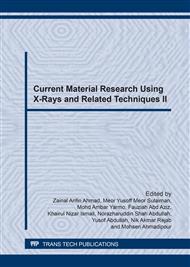[1]
E. Garskaite, K. Gibson, A. Leleckaite, J. Glaser, D. Niznansky, A. Kareiva, On the synthesis and characterization of iron-containing garnets (Y3Fe5O12, YIG and Fe3Al5O12, IAG), Chem. Phys. 323 (2006) 204–210.
DOI: 10.1016/j.chemphys.2005.08.055
Google Scholar
[2]
W.F.F. Wan Ali, M. Othman, M.F. Ain, N.S. Abdullah, Z.A. Ahmad, The Investigation of the phenomenological yig phase formation within 1000ºC to 1250ºC: A kinetic approach, J. Am. Ceram. Soc. 10 (2015) 1–9.
DOI: 10.1111/jace.13865
Google Scholar
[3]
Nicola A. Spaldin, Magnetic Materials: Fundamentals and device applications, Cambridge University Press, New York, (2003).
Google Scholar
[4]
W.F.F. Wan Ali, M. Kamarudin, M.F. Ain, N.S. Abdullah, Z.A. Ahmad, Sintering and grain growth control of high dense YIG, Ceram. Int. 42 (2016) 13996–14005.
DOI: 10.1016/j.ceramint.2016.06.004
Google Scholar
[5]
W.F.F. Wan Ali, H. Jaafar, M.F. Ain, N.S. Abdullah, Z.A. Ahmad, Enhancement of YIG bandwidth efficiency through Ce-doping for Dielectric Resonator Antenna (DRA) applications, Journal of Materials Science: Materials in Electronics 26 (2015).
DOI: 10.1007/s10854-014-2428-7
Google Scholar
[6]
C. Milanese, V. Buscaglia, F. Maglia, and U. A. Tamburini, Disorder and nonstoichiometry in synthetic garnets A3B5O12 (A = Y, Lu−La, B = Al, Fe, Ga). A Simulation Study, Chemistry of Materials 12 (2004) 1232–1239.
DOI: 10.1021/cm031138u
Google Scholar
[7]
D. Askeland, P. Fulay, W. Wright, What is Materials Science and Engineering ?, Cambridge University Press, New York, (2003).
Google Scholar
[8]
W.F.F. Wan Ali, M. Othman, M.F. Ain, N.S. Abdullah, Z.A. Ahmad, Studies on the formation of Yttrium Iron Garnet (YIG) through stoichiometry modification prepared by conventional solid-state method, J. Eur. Ceram. Soc. 33 (2013) 1317–1324.
DOI: 10.1016/j.jeurceramsoc.2012.12.016
Google Scholar
[9]
L.H. and W.X. Shen Tao, Hu Chao, Dai Hailong, Yang Wenlong, First Principle study of structure, electronic and optical properties of Y3Fe5O12 in cubic and trigonal phases, Mater. Sci. Pol. 33 (2015) 169–174.
DOI: 10.1515/msp-2015-0015
Google Scholar
[10]
A.K. Hiroki Moriwake, Craig A. J. FIsher, First principles calculation of rare-earth dopants in BaTiO3, Jpn. J. Appl. Phys. 48 (2009) 09KC031 – 09KC036.
Google Scholar
[11]
V. Milman, A. Perlov, K. Refson, S.J. Clark, J. Gavartin, B. Winkler, structural , electronic and vibrational properties of tetragonal zirconia under pressure : A density functional theory study, Journal of Physics: Condensed Matter 21 (2009).
DOI: 10.1088/0953-8984/21/48/485404
Google Scholar
[12]
V.S. Lee and Y.L. Piyarat Nimmanpipug, A. Saelor, L. Srisombat, Density functional theory investigation of the site predilection of fe substitution in barium titanate, Ceram. Int. 39 (2013) S293–S296.
DOI: 10.1016/j.ceramint.2012.10.080
Google Scholar
[13]
S.J. Clark, M.D. Segall, C.J. Pickard. P.J. Hasnip, M.I.J. Probert. K.R. Refson, First principles methods using CASTEP, Z. Kristallogr. 220 (2005) 567–570.
DOI: 10.1524/zkri.220.5.567.65075
Google Scholar
[14]
W.F.F. Wan Ali, M.F. Ain, N.S. Abdullah, Z.A. Ahmad, Phase evolution of Yttrium Iron Garnet (YIG) made by solid state sintering : Particle Size Effect, Materials Science, Trans Tech Publications 840 (2016) 276–280.
DOI: 10.4028/www.scientific.net/msf.840.276
Google Scholar


